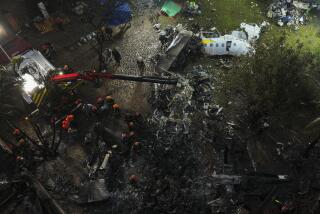Scores of Bodies Found After Africa Crash
LAGOS, Nigeria â Hopes of finding more than the 10 known survivors of a Kenya Airways flight that crashed off the shores of Ivory Coast faded Monday, as scores of bodies continued to be pulled out of the Atlantic.
It remained unclear why the Airbus 310 went down Sunday night shortly after taking off from the Ivorian commercial capital, Abidjan. Airline officials said their focus now would be on retrieving the airlinerâs flight data recorder and cockpit voice recorder in hopes of finding clues to the cause of the crash.
At the international airport in this sprawling port city, where the jet had been bound, friends and relatives of missing Nigerian passengers burst into tears and threw themselves onto the floor in uncontrollable grief after the names of the survivors were read out in the arrivals hall.
âMy sister was on the plane,â cried a distraught Tayo Russell, 36. âShe has two small children.â
Many of the 179 passengers and crew members aboard the doomed jetliner were Nigerian, Kenya Airways officials said. But the flight manifest listed citizens from at least 23 countries, including the United States.
The crash was the first such disaster for Kenya Airways, which has been operating since 1977.
Senior Kenya Airways officials and Kenyan army personnel were dispatched Monday to the crash site to assist with investigations. The team included experts in crisis counseling and support.
Winds, Haze Kept Jet From Landing in Lagos
Some witnesses said the plane seemed never to gain sufficient altitude as it flew over a retaining wall at the edge of Abidjanâs Felix Houphouet-Boigny International Airport. Others claimed to have seen fire and smoke belching from the aircraft as it labored to gain height.
The flight had originated in the Kenyan capital, Nairobi, on Sunday and was meant to stop over in Lagos, but the plane flew directly to Abidjan because of weather conditions over Nigeriaâs steamy commercial capital.
Harmattans--strong, sandy winds blowing south from the Sahara Desert--had covered cities in Nigeriaâs north and southwest for several days, creating a thick, blinding blanket of haze and disrupting incoming flights at several airports. Harmattans are typical in West Africa at this time of year, but many locals said this yearâs dust cover was the worst they had ever seen.
The jet, bought new in 1986, was due to be replaced within the next two years. But officials said there was so far no indication that the crash was caused by mechanical failure.
Steve Clarke, the airlineâs technical director, said in Nairobi that the plane had not been too old to fly, had been regularly maintained and had been âfully serviceable and fit for flight.â It had clocked 58,000 flying hours over 15,000 flights.
He said the plan was to gradually replace the companyâs Airbuses with a fleet of Boeing 767-300s, which would allow an upgrade in the in-flight entertainment system and other passenger comforts.
A passenger information and accident response center was set up at a downtown Nairobi hotel, where relatives of the victims could be briefed and counseled.
Kenya Airways officials said a plane would be provided to take family members to the crash site for identification of the victims.
Victimsâ Friends, Kin Tell of Poor Treatment
But in Lagos, friends and relatives of those aboard the flight expressed anger and frustration at the failure of KLM Royal Dutch Airlines--a partner of Kenya Airways--to quickly divulge what little information it had.
Those waiting were initially forced to perch on dirty window ledges in the airportâs murky, non-air-conditioned arrivals hall, having been chased away from the Kenya Airways/KLM office, which they had attempted to storm.
As people scrambled to talk to anyone who popped out of the office wearing an official badge, airport security officials jostled to keep them at bay.
âAll we want to know is who was on the manifest and who might be alive or dead,â shouted Tunde Oladare, 36, a construction company worker, whose boss had been aboard the flight. âWhy canât they just publish the list?â
âThe dead are already dead. Letâs look after the living,â sneered one airport security official, as another appealed for patience and calm.
About 14 hours after news of the crash had been released, iron benches were rolled into the arrivals hall on shopping carts and set up to relieve the weary legs of those waiting. Bottles of water and soda were distributed among the anxious crowd.
But many called these gestures too little, too late, and complained that the KLM staff had been unsympathetic and had treated them with contempt.
âThey talk to you rudely. They donât even feel for you,â said Russell, whose sister, a lawyer, perished in the crash.
âWe are human beings,â said Emeka Ilechukwu, who was waiting for three business partners to arrive via Nairobi from Dubai, United Arab Emirates. âCourtesy demands that we are treated in an enlightened fashion. Theyâre just not organized.â
*
Samuel Hinga Mwangi of The Timesâ Nairobi Bureau contributed to this report.
More to Read
Sign up for Essential California
The most important California stories and recommendations in your inbox every morning.
You may occasionally receive promotional content from the Los Angeles Times.











